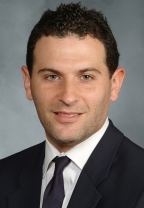
Dr. Jared Knopman
A new minimally invasive approach to treating subdural hematomas, pioneered by Dr. Jared Knopman, can now spare patients from the risks of open surgery.
Nearly 50 patients at Weill Cornell Medicine and NewYork-Presbyterian have been successfully treated with this groundbreaking approach, called middle meningeal arterial (MMA) embolization. The success of the approach also provides evidence for a startling new finding about subdural hematomas, which revolutionizes thinking about how they form and how to treat them.
Patients with subdural hematomas usually require major open surgery, in which a neurosurgeon removes a part of the skull to allow access to the dangerous pool of blood between the brain and its protective covering (the dura).
That procedure, called a craniotomy, allows the neurosurgeon to evacuate the blood and relieve pressure on the brain, but it also subjects patients to the risks that accompany any open brain surgery, including infection, bleeding, and seizures.
Elderly patients, who are most prone to subdural hematomas, are also most at risk from complications from surgery, making this new procedure especially valuable to them.
In MMA embolization, a neurosurgeon with expertise in image-guided cerebrovascular treatments threads a microcatheter from a tiny needle stick in the upper thigh and into the arteries feeding the subdural hematoma, then cuts off its blood supply.
The success of the approach upends one of the basic understandings of subdural hematomas, which have long been described as being venous (meaning that they are created from and supplied by blood from veins, not arteries). Successfully treating a subdural hematoma using MMA embolization is evidence for arterial involvement in these blood pools.
"This finding has completely turned upside down the way we have thought about this disease," says Dr. Knopman.
"We always learned that subdural hematomas were purely venous problems. The fact that arterial embolization can cure this pathology shows that arteries play a major role in their development. This is a new finding that contradicts nearly fifty years of education and assumption."
The results of the procedure in the first five patients treated worldwide in lieu of open surgery were published online in the journal Operative Neurosurgery this summer, in advance of appearing in a print issue.
Based on those results, Dr. Knopman obtained IRB approval to launch a formal clinical trial of this approach to gather more data.
Since then, he has treated nearly 50 patients using this procedure, with not a single one suffering complications. He is the first neurosurgeon anywhere performing this procedure instead of traditional surgery, and the Weill Cornell Medicine Brain and Spine Center at NewYork-Presbyterian is the only center in the country where this procedure is formally being studied and offered.
"MMA embolization has so far shown more than 90 percent effectiveness," notes Dr. Knopman. "That's a truly significant success rate for a first-line treatment — especially since nothing about this procedure precludes using traditional open surgery as follow-up if the patient does not get better."
"With not a single complication, and a 90 percent success rate, I am extremely encouraged. I believe this new approach will soon become the first-line standard of care for many chronic and subacute subdural hematomas in cases where they can be treated at facilities equipped to perform it."
Image-guided procedures such as this one, which have already revolutionized treatment for other cerebrovascular conditions such as aneurysms and arteriovenous malformations (AVMs) are available only in advanced, specially equipped medical centers.
"This approach has tremendous benefits to patients," adds Dr. Knopman. "Instead of rushing into invasive surgery — with its associated complications, risks, and costs — for a relatively common cranial disease in the elderly, we can try a minimally invasive, less risky, less expensive option first. We can then use the more invasive approach only in the small percentage of patients who don't respond to MMA embolization. This is a win all around for our patients."
Learn more about the clinical trial or read Dr. Knopman's blog post about this new procedure.